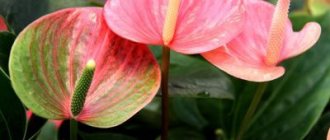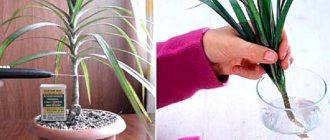Arum is a perennial herbaceous plant, more popularly known as “dragon lilies.” Its cultivation will be more interesting to lovers of exotic curiosities and avant-garde landscape design than to gardeners with a classical approach to site design. Outwardly, it resembles cannas and callas with its inflorescence-cob, wrapped in a bract-veil. The plant is of decorative interest twice a season - during early flowering and after the formation of a peduncle-cob with bright scarlet berries.
Brief description of spotted arum:
Spotted arum (spotted arum) is a perennial herbaceous plant up to 40 cm high with a cylindrical or oval tuber, from which numerous thin and thick adventitious roots arise. The flowering stem is almost equal to the length of the leaf petiole.
A rosette of arrow-shaped basal leaves with long petioles at the base is surrounded by brownish scale-like leaves. The leaves are large, thick, slightly fleshy, arrow-spear-shaped, entire, basal, long-petiolate, vaginal, 2-3 in one bush, quite often have brown spots. Flowers are unisexual; both female and male ones develop on the same plant. Female flowers are located at the base of the spadix, male flowers are located above them. The inflorescence arranged in this way is a trap for small insects attracted by the evening aroma of the cob. Once in the “trap”, insects are forced to pollinate flowers. The hairs of a pollinated flower droop, and insects can get out. Soon after fertilization, the tip of the ear and the involucre leaf (yellow or brownish) die off and a cluster of red berries develops.
Blooms in April - May, bears fruit in September - October.
general description
Arum is a tuberous perennial of the Araceae family. It is native to the shady forests of southern Europe, the north of the African continent and the Caucasus; one variety is represented in Central Asia. Scale-like basal leaves develop vegetatively until mid-summer, after which they die. In spring, 2-3 leaves of arum are more elongated than others, after which they form oblong, pointed plates.
In mid-latitudes, flowering occurs in May. A lush decorative blanket is formed around the cob. Closer to August, red, densely spaced balls of berries with seeds ripen. During this period, the plant looks more impressive than during flowering, since the bright ripe cob is much more noticeable than the arum flower.
The rhizome is thickened, tuberous.
Important! In their fresh form, all types of plants are poisonous; eating berries can cause serious intoxication of the body. Fortunately, the berries are attractive only in appearance, but have an unpleasant smell and disgusting taste. After drying, they lose their toxic properties.
Chemical composition of spotted arum:
The composition has been poorly studied. The tubers contain alkaloids, coniine-like aroin, up to 0.1% glycosidic saponins, starch (up to 70%), sugars (fructose, sucrose), fatty oil containing palmitic and linoleic acids; trace elements (copper, zinc, nickel, molybdenum, etc.). It also contains a large amount of crystals of oxalic acid and its salts (oxalates), especially in the leaves. Thin, sharp needles of calcium oxalate crystals, when touched, injure the skin and mucous membranes.
All these active ingredients form the basis of the chemical composition of spotted arum (spotted arum).
Diseases and pests
The greatest damage to arum can be caused by excessive moisture. Against this background, fungal processes easily develop, the roots rot and the plant dies. Brown spots that appear on the leaves may be a sign that the process has begun. If rot is suspected, stop watering and fertilizing and treat with a fungicide. Among insects, the crop can be affected by mites, which should be combated using traditional methods using insecticides.
The plant is suitable for cutting, but remember that it is poisonous and has an unpleasant odor.
Use of arum in medicine, treatment with arum:
Arum is used only in folk medicine.
Arum helps with acute and chronic bronchitis, bronchial asthma, chronic gastritis with increased secretory function, with chronic asthma and cleansing the lungs.
For a runny nose, inflammation of the oral mucosa, catarrh of the upper respiratory tract, for all cases of hoarseness (when the vocal cords are overstrained), for mumps, scarlet fever and measles, arum is also used.
Preparations from arum are indicated in the treatment of psoriasis. Externally used for dermatitis and eczema.
Reproduction
There are two methods of propagation available: seed and vegetative division of the rhizome. In addition, the culture is prone to self-seeding. The method of dividing the rhizome is not suitable for all species, since some of them exhibit extremely slow growth. The seeds quickly lose their viability, so they can only be used fresh. The rhizome for division is dug up in the summer after the leaves have dried. You need to divide the root with a sharp sterile instrument, tracking the location of the buds. The depth of the divisions is 8 cm.
Arum root tincture:
Tincture of arum root: pour 70% alcohol over the peeled roots in a ratio of 1:4. Leave for 7 days in a tightly sealed container in a dark, warm place, shaking the contents occasionally. Strain and take 10 drops 3 times a day before meals. Gradually increase the dose, 1 drop daily, and increase to 15 drops per day if well tolerated. The course of treatment is (both when taking the powder and when taking the tincture) 1–2 months and is determined by the patient’s condition.
The effectiveness of both dosage forms is almost the same, but the alcohol tincture is better absorbed and is also easier to dose. Alcohol tincture of arum in a dose of 20 drops 3 times a day is non-toxic and has no side effects. With psoriasis, improvement in the condition of patients occurs slowly and is often manifested by the complete disappearance of plaques with the development of pigmentation.
Features of pollination
Despite the unpleasant smell for humans, it is attractive to insects, not only bees, but also flies, ants, etc. When they land on a flower, they are literally captured, because... the flower holds them for several days. The conditions of confinement, however, are very comfortable, since
The pulp of the blanket is perfect for nutrition, and the temperature inside the flower stays within +30...+34C.
Contraindications for spotted arum:
Arum is a poisonous plant, so it must be used with great caution. Signs of arum poisoning are nausea, abdominal pain, vomiting, diarrhea, irritation of the mucous membranes, and cold sweat. Severe intoxication may be accompanied by adynamia, the development of arrhythmia, hallucination, and convulsions.
Treatment of poisoning should begin with gastric lavage with a suspension of activated carbon in a 2% sodium bicarbonate solution, and use saline laxatives (up to 30 g of magnesium sulfate orally). To stimulate the respiratory center and maintain cardiac activity, camphor, caffeine-sodium benzoate (20% solutions of 1–2 ml subcutaneously), and cordiamine (up to 2 ml) are prescribed. For convulsions, chloral hydrate (0.5 g in an enema with mucus), barbamyl (5 ml of a 10% solution intramuscularly) are indicated.
Planting arum and caring for it
The crop is grown in open ground or in greenhouses.
Site selection, soil and lighting
The plant loves moderate shading, openwork shade, however, you can often see it in areas exposed to the sun and in the shade of buildings. It should be noted that the more sun there is in an area, the higher its humidity should be (however, it does not tolerate waterlogging).
But the soil should be given special attention. Well-drained, calcareous, fertile soil is recommended. Its aeration can be improved artificially by adding broken bricks or other coarse material.
Landing
The depth of the hole for planting is no more than 8 cm, the distance between seedlings when placed in groups, taking into account future growth, is at least 0.4 m. The plant can only be planted in well-warmed soil after the return frosts have passed.
Watering
Proper watering is a very important point in caring for arum, since it does not tolerate stagnation of water, which causes rotting of the tubers. When planted in a shaded area, it may not need watering at all. By the time the foliage turns yellow, watering in any case must first be reduced and then stopped.
Feeding
The optimal regime for applying complex mineral fertilizers is 2 times a month, but once is enough. Organic use is allowed.
Wintering
Almost all varieties of the crop require winter shelter, since the rhizome easily freezes and dies. It is enough to mulch the soil with a layer of peat and throw fallen leaves on the bed.
Transfer
It is best not to touch the planted plant again. But, if such a need arises, attention should be paid to preserving the rhizome with an earthen lump as much as possible in order to avoid damage to the small suction roots. When replanting, it is necessary to ensure that the root collar remains at the same level.
On private plots, arum is a rarity. Most often it can be found in botanical gardens in compositions of tropical plants in combination with decorative stones.
Variety of species
A variety of arum called Arum cordifolium is common as a houseplant. This species typically has a white bract and heart-shaped leaves. Sometimes gardeners can find Arum odorum, whose trunk is covered with the remains of its dead leaves. This species is more unpretentious.
But at home, horned arum with bizarre leaf colors is most often grown. Unlike its relatives, its flowers do not emit an unpleasant odor.
Titan arum grows in Sydney, known as the plant with the largest inflorescences. It blooms once every 3 years, and its flowering lasts only 2-3 days. Arum inflorescences, which emit the smell of rotting fish, reach 3 meters in length and 100 kilograms in weight. The rhizomes also have a lot of weight. It reaches 50 kilograms, and in some plants - 90 kg.
Arum: beauty and stench
The flowers of this amazingly beautiful plant have a very unpleasant odor, reminiscent of the smell of decaying meat, and a corresponding color. Therefore, arum is often called a corpse flower.
Why does arum need such a disgusting smell? It turns out that the flower is pollinated by meat flies, carrion flies and dung flies. Arum uses smell to attract them. Tricked flies lay eggs in the flower, from which larvae hatch. But the larvae soon die, since there is no food for them in the flower.
Growing arum
Arum feels good in the shade, but prefers a sunny place.
Plant care
This plant should be grown in warm rooms and greenhouses, where the temperature reaches 18-20 degrees. In winter, the temperature is reduced to 15°C.
Every spring, arum must be replanted in a fertile soil mixture. To prepare it, mix greenhouse soil and coarse sand in a ratio of 2:1. You can use a mixture of peat (1 part), humus, leaf and turf soil (2 parts each) and sand (3 parts). The plant also needs good drainage.
In summer, arum needs abundant watering and feeding with liquid mullein. In winter, the plant must be kept in a well-lit place and watered moderately. The plant should be sprayed year-round.
Reproduction
Arum is propagated by seeds, dividing the bush or stem cuttings.
Pests and diseases
Arum may be at risk of attack by aphids, spider mites, scale insects, and mealybugs.











